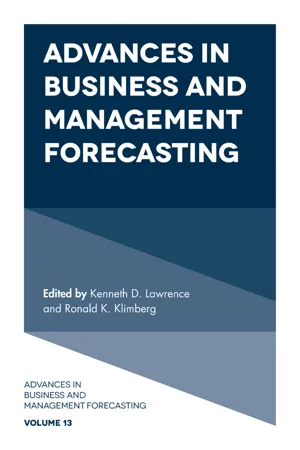Vivian M. Evangelista and Rommel G. Regis
ABSTRACT
Machine learning methods have recently gained attention in business applications. We will explore the suitability of machine learning methods, particularly support vector regression (SVR) and radial basis function (RBF) approximation, in forecasting company sales. We compare the one-step-ahead forecast accuracy of these machine learning methods with traditional statistical forecasting techniques such as moving average (MA), exponential smoothing, and linear and quadratic trend regression on quarterly sales data of 43 Fortune 500 companies. Moreover, we implement an additive seasonal adjustment procedure on the quarterly sales data of 28 of the Fortune 500 companies whose time series exhibited seasonality, referred to as the seasonal group. Furthermore, we prove a mathematical property of this seasonal adjustment procedure that is useful in interpreting the resulting time series model. Our results show that the Gaussian form of a moving RBF model, with or without seasonal adjustment, is a promising method for forecasting company sales. In particular, the moving RBF-Gaussian model with seasonal adjustment yields generally better mean absolute percentage error (MAPE) values than the other methods on the sales data of 28 companies in the seasonal group. In addition, it is competitive with single exponential smoothing and better than the other methods on the sales data of the other 15 companies in the non-seasonal group.
INTRODUCTION
Sales forecasting is very important for many companies as it determines production planning, inventory, and many other aspects of operations (Beheshti-Kashi, Karimi, Thoben, Lütjen, & Teucke, 2015). As such, companies are always looking for ways to obtain more accurate sales forecasts (Beheshti-Kashi et al., 2015). Statistical methods, such as exponential smoothing, Holt-Winters model, trend regression models, ARIMA, and Box & Jenkins model, have traditionally been used for sales forecasting (Beheshti-Kashi et al., 2015).
More recently, machine learning methods such as neural networks, support vector regression (SVR), and radial basis functions (RBFs) have been proposed as an alternative to statistical methods in sales forecasting (Chen & Kuo, 2017; Dwivedi, Niranjan, & Sahu, 2013; Guo, Wong, & Li, 2013; Kuo, Hu, & Chen, 2009; Loureiro, Miguéis, & da Silva, 2018; Lu, 2014; Lu, Lee, & Lian, 2012; Xia, Zhang, Weng, & Ye, 2012). However, as Makridakis, Spiliotis, and Assimakopoulos (2018) observed in their survey paper on forecasting in general, there is limited evidence of their performance and accuracy relative to statistical methods. This is likewise true in our review of the sales forecasting literature. Majority of the studies on sales forecasting simply compare machine learning methods with other machine learning methods, while providing limited comparisons to only one or two statistical methods (Chen & Kuo, 2017; Dwivedi et al., 2013; Guo et al., 2013; Kuo et al., 2009; Loureiro et al., 2018; Lu et al., 2012; Xia et al., 2012). This chapter aims to explore the suitability of machine learning methods, particularly SVR and RBF approximation, in sales forecasting and, in addition, provide further empirical comparison of machine learning methods with statistical methods.
In addition, the results of forecasting studies have limited statistical significance because they are based on a single or just a few time series data (Makridakis et al., 2018). Similarly, most of the sales forecasting literature apply machine learning methods to sales data from a single company or a few companies from a single industry (Arunraj & Ahrens, 2015; Doganis, Alexandridis, Patrinos, & Sarimveis, 2006; Guo et al., 2013; Kuo et al., 2009; Loureiro et al., 2018; Lu, 2014; Makridakis et al., 2018; Xia et al., 2012). As such, there is a need to apply machine learning methods to larger and more diverse datasets in order to assess their effectiveness (Makridakis et al., 2018). Thus, in this chapter, we compare forecasting methods using a larger number and more diverse dataset consisting of quarterly sales data from 43 Fortune 500 companies, which come from various industries.
This chapter is organized as follows. The “Review of Literature” section covers sales forecasting. The “Some Machine Learning Methods for Forecasting” section presents two popular machine learning me...
